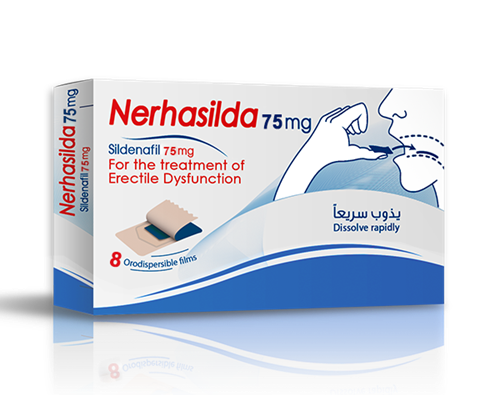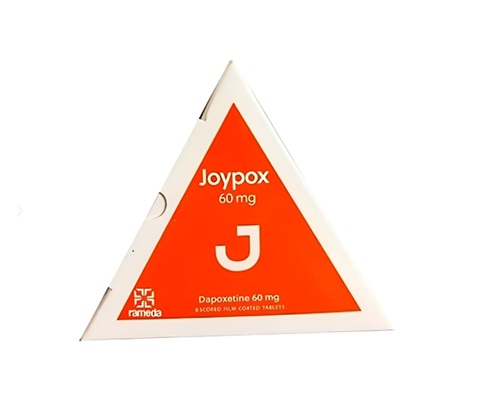Description
Trade name:
Nerhasilda
Compound:
Each orally soluble film contains:
Sildenafil citrate 105.3 mg, equivalent to 75 mg sildenafil.
Properties:
Sildenafil is a potent selective inhibitor of cycloguanosine monophosphate (cGMP) – specific phosphodiesterase type 5 (PDE5). Restores impaired erectile function under conditions of sexual stimulation by increasing blood flow in the vessels of the penis.
The physiological process underlying penile erection involves the release of nitric oxide (NO) in the corpus cavernosum during sexual stimulation. Nitric oxide activates the enzyme guanylate cyclase, which leads to an increase in cGMP concentrations and subsequent relaxation of the smooth muscle cells of the corpus cavernosum and promotes its filling with blood.
It does not have a direct relaxing effect on the isolated human corpus cavernosum, but enhances the effect of NO by inhibiting PDE5, which is responsible for the breakdown of cGMP. When the NO/cGMP system is activated by sexual stimulation, inhibition of PDE5 by sildenafil leads to an increase in the level of cGMP in the corpus cavernosum.
Indications:
Treatment of erectile dysfunction characterized by the inability to achieve or maintain an erection of the penis sufficient for satisfying sexual intercourse.
Effective only with sexual stimulation.
Method of administration and dosage:
Place 1 film 75 mg in the oral cavity, wait until completely dissolved. If necessary, you can wash it down with water.
Take one hour before planned sexual activity, no more than once a day.
The recommended therapeutic dose of sildenafil ranges from 25 to 100 mg/day.
Contraindications:
Hypersensitivity to sildenafil or any other component of the drug.
Concomitant use with nitric oxide (NO) donors (eg, amyl nitrite) or nitrates in any form, as sildenafil may enhance the antihypertensive effect of nitrates (mediated via NO/cGMP).
Medicines for the treatment of erectile dysfunction, including sildenafil, should not be used in men for whom sexual activity is not recommended (for example, patients with severe cardiovascular disease such as unstable angina or severe heart failure).
The safety and efficacy of sildenafil in combination with other drugs for the treatment of erectile dysfunction have not been studied, therefore concomitant use is contraindicated.
Concomitant use with ritonavir is contraindicated.
Loss of vision in one eye due to non-arteritic anterior ischemic optic neuropathy, whether or not associated with the use of PDE5 inhibitors.
Use is contraindicated in: severe liver dysfunction, arterial hypotension (BP less than 90/50 mm Hg), recent cerebrovascular accident or myocardial infarction, phenylketonuria, hereditary retinal dystrophies (hereditary degenerative diseases of the retina), such as retinitis pigmentosa (some patients have genetic defects of retinal phosphodiesterases), since the safety of the drug in such patients has not been studied.
Precautions:
According to the registered indication, the drug is not intended for use in children under 18 years of age, women, including pregnant and lactating women.
With caution:
arterial hypertension (BP over 170/100 mmHg); life-threatening arrhythmias; obstruction of the left ventricular outflow tract (aortic stenosis, hypertrophic obstructive cardiomyopathy (HOCM));
multiple system atrophy syndrome;
anatomical deformation of the penis (angulation, cavernous fibrosis or Peyronie’s disease);
conditions that predispose to priapism (sickle cell anemia, multiple myeloma, or leukemia);
concomitant use of alpha-blockers;
diseases accompanied by bleeding;
exacerbation of gastric ulcer or duodenal ulcer;
history of episodes of development of anterior non-arteritic ischemic optic neuropathy.
Impact on the ability to drive vehicles and operate machinery:
There is no data on the negative impact of the drug in recommended doses on the ability to drive a car or operate machinery. Patients should assess their individual susceptibility to sildenafil, as a decrease in blood pressure, the development of visual impairment (chromatopsia, blurred vision) and dizziness are possible, especially at the beginning of treatment and when changing the dosage regimen.
Side effects:
From the immune system: rarely – hypersensitivity reactions.
From the nervous system: very often – headache; often – dizziness; uncommon – drowsiness, hypoesthesia; rarely – cerebrovascular accident, fainting; frequency unknown – transient ischemic attack, seizures, relapse of seizures.
From the organ of vision: often – visual impairment, impaired color perception (chromatopsia); uncommon – conjunctival damage, impaired lacrimation, other disorders from the organ of vision; frequency unknown – anterior ischemic optic neuropathy of non-arteritic genesis, retinal vascular occlusion, visual field defect.
From the organ of hearing and labyrinthine disorders: often – vertigo, tinnitus; rarely – deafness.
From the vascular system: often – a feeling of “hot flashes”; rarely – an increase/decrease in blood pressure.
From the heart: uncommon – palpitations, tachycardia; rare – myocardial infarction, atrial fibrillation; frequency unknown – ventricular arrhythmia, unstable angina, sudden cardiac death.
From the respiratory system: often – nasal congestion; rarely: nosebleed.
From the gastrointestinal tract: often – dyspepsia; uncommon – vomiting, nausea, dryness of the oral mucosa.
From the skin and subcutaneous tissues: uncommon – skin rash; frequency unknown – Stevens-Johnson syndrome, toxic epidermal necrolysis (Lyell’s syndrome).
From the musculoskeletal system: uncommon – myalgia.
From the urinary system: uncommon – hematuria.
From the genitals and mammary gland: uncommon – hematospermia, bleeding from the penis; frequency unknown – priapism, prolonged (long-lasting) erection.
General reactions: uncommon – chest pain, increased fatigue.
Laboratory and instrumental data: uncommon – increased heart rate.
Storage method:
Store at a temperature not exceeding 30 degrees in a dry place.
Store in original packaging, out of reach of children.









